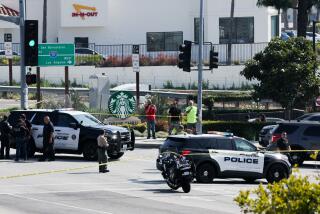School Is an Experiment in Learning
If you ask 8-year-old Angela Lincoln-Manuel what she wants to be when she grows up, prepare yourself for a long answer. A model. A soccer player. A basketball star too. A pediatrician -- or maybe a gynecologist.
As she looked around her shiny new school at its dedication Thursday, it seemed like she had a good place to start. When school opens Sept. 9, Angela will be one of 700 students at the Science Center School, a joint venture between the Los Angeles Unified School District and the California Science Center.
For the record:
12:00 a.m. Aug. 28, 2004 For The Record
Los Angeles Times Saturday August 28, 2004 Home Edition Main News Part A Page 2 National Desk 1 inches; 33 words Type of Material: Correction
Science center official -- A story in the California section Friday about the opening of a school at the California Science Center identified the center’s president as Jeffrey Randolph. He is Jeffrey Rudolph.
“I love my life,” admitted Angela, dressed in the new school’s plaid pinafore uniform and standing to one side of a massive warehouse-sized building in Exposition Park.
Once a National Guard armory, the building has been reinvented as the school’s “Big Lab” and is part of an architecturally unusual campus that includes classrooms partly underground.
The Science Center School will offer its elementary students a rich curriculum focused on science, math and technology, said Los Angeles school board member Marguerite Poindexter LaMotte, who represents the neighborhood near USC.
“This building is nothing more than bricks and steel and paint and plaster,” LaMotte told the assembled guests, who included teachers, students, parents and a host of politicians.
“With today’s dedication, however, it becomes a place where our young people will come to learn ... to understand the world around them.”
The project’s architect, Thom Mayne, told the crowd that the school’s buildings were “meant to ask questions, to be didactic, to demand inquiry.”
In the Big Lab, a stainless steel walkway rings the second-story atrium, connecting to classrooms, a library, meeting rooms and a bamboo forest that will eventually reach the roof.
The former armory, said L.A. Unified Supt. Roy Romer, is an example of “taking something that was old, and making it new, making it magnificent.”
Just to the north, a new school building seems to rise from the ground. Subterranean classrooms are separated by glass walls from laboratories and research centers.
Sites for research are seemingly everywhere. A wading pool in the Big Lab will be used for water experiments, said Science Center President Jeffrey Randolph.
High towers at one side of the building will allow students to explore the properties of gravity. Nearby, an elevated garden awaits its first student project.
The $50-million campus is one of 160 schools the district is planning to build by 2012. About $34 million for the project came from the state-owned Science Center, the child-friendly museum that will share some facilities with the school. The district kicked in about $8 million in bond funds -- the cost of one of its regular elementary schools. The rest of the funding came from state and other sources.
The Science Center School is an affiliated charter within L.A. Unified; as such it will have more autonomy than a regular district elementary school but less than an independent charter.
About 70% of its students come via lottery from six overcrowded elementary schools in the neighborhood, and 30% are students who applied directly to the school from around the district and elsewhere.
Speaker after speaker at the dedication ceremony remarked on the school’s long and slow progress from conception to completion. When the Science Center and school leaders first envisioned the school, George Deukmejian was governor of California. Thursday, he was in the audience.
As the ceremony drew to a close, Randolph told the crowd that the Science Center wanted to experiment with a new method of ribbon cutting.
He pointed to a blue-and-white paper bull’s-eye, held by two aides on a catwalk high above the crowd, and then showed off a complicated-looking contraption designed to shoot tennis balls into the air at a high velocity. A band member began a drum roll.
The first ball missed its target and failed to pierce the paper. The second ball missed too. But they got it on the third try.
More to Read
Start your day right
Sign up for Essential California for news, features and recommendations from the L.A. Times and beyond in your inbox six days a week.
You may occasionally receive promotional content from the Los Angeles Times.






